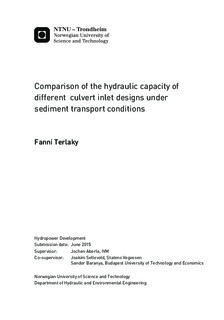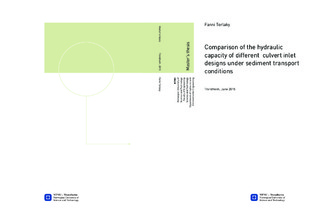| dc.description.abstract | Abstract
Culverts are important hydraulic structures whose main purpose is to safely convey water through infrastructures crossing streams (e.g. roads). Several design guidelines exist for clear water conditions, but none of them takes into account the sediments. Therefore, in the framework of the Natural hazards Infrastructure for floods and landslide (NIFS) project, five student-theses have been prepared in order to bridge this knowledge gap, and contribute to development of new guidelines for culvert design. The theses were based on model tests (1:10) which were designed to specifically study the effect of sediment transport. The culvert s hydraulic capacity was investigated with different boundary conditions, under both clear water condition and sediment load. The present study is the first joint analysis of all the data from these studies, which identifies the favourable culvert inlet design, under sediment transport. The experiments were carried out with three different inlet types (cut, projecting, wingwalls) under inlet control focusing on the effects of the expansion section geometry, the installation of reserve barrel, sediment countermeasures, feeding method, sediment size and sediment amount.
The main findings of the thesis were the followings: under jet dominated flow, the wingwall-inlet provided the highest capacity while in case of milder slope (1:9) and installed energy dissipation, the projecting inlet. The energy dissipator blocks have been installed for generation of a hydraulic jump. Both width and length of the expansion section influenced the culvert s hydraulic capacity. The culvert showed generally the highest performance for the shortest expansion section length (315 mm; model scale), and for the widest expansion section width (876 mm; model scale). Sediment experiments showed that sediment load generally decreased the culvert s hydraulic capacity as the deposited sediment obstructed the flow through the barrel. From the two sediment feeding methods (gradually, all at once) the all at once feeding resulted in higher headwater levels as more sediment deposited in the basin. Although sediment size and amount had only a slight effect on the culvert performance, the water level was generally higher when more sediment (7 kg) was fed to the model. The installation of a reserve barrel, located at a higher level compared to the main culvert, increased the safety of the structure as it was less prone to be blocked by sediments. Experiments with sediment countermeasures showed that both trash racks and debris deflectors are efficient in sediment retention. However, installation of these structures decreased the culvert s hydraulic capacity. Based on these results, an analysis was carried out focusing on hydraulic capacity, embankment safety and costs to find the optimal configuration. The identified configuration is presented and corresponding sketches have been developed. | |

